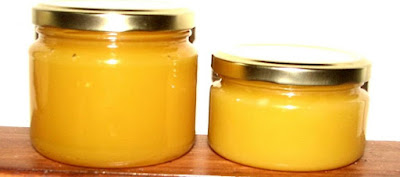Lemon
curd is a thick, smooth, sweet and tart flavoured spread used to fill cakes,
pastries, scones and more. Made with free range eggs, lemons and sugar, this
English-style preserve is actually very simple to prepare and can be bottled
for the pantry to keep for several months (or frozen for longer storage).
Enjoy!
|
Ingredients for LEMON CURD (BOTTLED/CANNED)
|
|
Yield: 3-4 cups
|
Yield: 6-8 cups
|
|
Castor Sugar
(Superfine Sugar)
|
2 1/2 cups
|
5 cups
|
|
Lemon
Zest, Fresh (optional)
|
1/2 cup
|
1 cup
|
|
Eggs, Large
|
4
|
8
|
|
Egg
Yolks, Large
|
7
|
14
|
|
Bottled
Lemon Juice
|
1 cup
|
2 cups
|
|
Unsalted
Butter, chilled, diced
|
3/4 cup (170g)
|
1 1/2 cups (340g)
|
1. Wash jars in hot soapy water. Pre-heat the
clean jars by covering them in water and boiling for 10 minutes in a large pot
- or use your dishwasher rinse cycle.
2. Zest lemons and measure lemon zest (if using)
into a bowl. Add the castor sugar and stir well. Set aside for 20-30 minutes.
3. Separate egg yolks and egg whites as per
ingredient chart – store leftover egg whites in the refrigerator or freeze in
airtight containers.
4. Cut butter into small cubes.
5. Warm the lids in a bowl of boiled water,
removing them when you are ready to place them onto the jars to seal.
6. Fill bottom tier of double boiler with water
and put onto the cooktop. Preheat water in double boiler to a gentle boil.
7. Top tier of double boiler (off heat): measure
whole eggs and egg yolks into the top tier. Whisk until combined. Slowly add
the sugar/lemon zest mixture to the egg mixture, whisking continuously until
smooth. Add the lemon juice and whisk well. Add the cubed butter and stir.
8. Place top tier of double boiler onto the
bottom tier (on heat). Stir continuously (gently) until the curd reaches
76°C (170°F). Remove from heat.
9. On a heatproof surface, stir lemon curd
gently for 4-5 minutes until curd has thickened slightly.
10. Place a sieve over a heatproof bowl (or jug). Strain
lemon curd through the sieve to remove zest. Discard zest.
11. Pour hot lemon curd into the hot jars, to 1cm
(1/2 inch) from the rim of the jars. Remove air bubbles and add curd if
required to correct the headspace. Wipe jar rims and seal.
12. Submerge jars in a pot of boiling water as
per the chart below, starting your timer when the water returns to a full boil.
When the time is up, turn the heat off and rest jars in water for 5 minutes
before placing onto a towel-covered bench overnight to cool.
9. 12-24 hours
later: check jars
have sealed before wiping down jars, labelling and storing in a cool, dry and
dark place for up to 4 months. When opened, refrigerate jar of lemon curd and
consume within 3 weeks.
|
Processing
Time for LEMON CURD (BOTTLED/CANNED) in a Boiling Water
Canner
|
|
Jar
Size
|
Altitude
≤ 1,000 feet
|
Altitude
1,001 - 3,000 feet
|
Altitude
3,001 - 6,000 feet
|
Altitude
≥ 6,000 feet
|
|
Hot Pack
|
≤ 250ml
(half-pints)
|
15 minutes
|
20 minutes
|
25 minutes
|
FLAVOUR IDEAS:
o Lime curd: replace lemon juice with lime juice and replace lemon zest
with half the quantity of lime zest instead; o No other citrus, fruit or other ingredients can be used
in this recipe for pantry storage (if changing the ingredients, the curd must be refrigerated or frozen).
SERVING IDEAS:
o Biscuits;
o Cake filling;
o Cheesecake;
o Cookies;
o Dip;
o Ice-cream;
o Lemon meringue pie;
o Macarons;
o Marshmallows;
o Mousse;
o Pancakes;
o Parfait;
o Pavlova;
o Scones;
o Tart;
o Toast;
o Waffles;
o Yoghurt.
NOTES:
o Do not use fresh lemon juice in this recipe: bottled lemon juice is
required to ensure safe pantry storage (if using fresh lemon juice, refrigerate
or freeze curd);
o Don’t have a double boiler? Use a large metal mixing
bowl that sits over your water pot, or a smaller pot sitting inside the larger
pot (handles should keep the small pot resting on top, without slipping the
curd put down into the water);
o Lemon curd can also be frozen in freeze safe containers
for up to 12 months.
o Extended storage in the pantry may lead to separation
and oxidisation (discolouring) – discard jar contents if this occurs;
o Enjoy our lemon curd label printable below: save and
print for non-commercial use.
Author:
Megan Radaich
Image credit: Megan Radaich
Publication: www.foodpreserving.org




